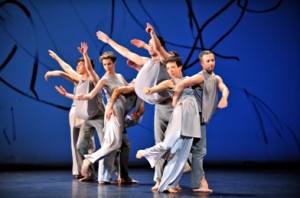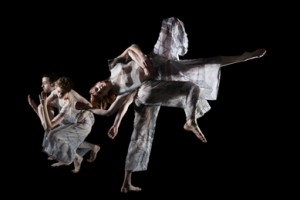(Becket, Mass.) – Jacob’s Pillow Dance Festival celebrates the 40th anniversary of the Trisha Brown Dance Company with a commemorative program of works highlighting Brown’s inventive choreographic range in the Ted Shawn Theatre from August 10 through August 14. The program includes the 1973 work Spanish Dance, set to Bob Dylan’s version of Gordon Lightfoot’s “Early Morning Rain;” Brown’s popular Foray Forêt; her most recent creation, Les Yeux et l’âme; and Set and Reset, with set and costumes by famed visual artist Robert Rauschenberg and music by Laurie Anderson. Set and Reset was commissioned by Jacob’s Pillow in 1982 and is emblematic of the thirty years of interaction between Trisha Brown and the Pillow.
Critic Deborah Jowitt invokes images of water when she describes Brown’s choreography: “You feel movement running through her body — spurting here, flowing there, diverted by new currents, but always delectably free and supple.” Jowitt wrote in an essay for Trisha Brown: Dance and Art in Dialogue, 1961-2001 that Brown’s fluid dancing was “considered completely inimitable.”
Trisha Brown’s work encapsulates many visual dynamics and artistic collaborations. The 1970 Man Walking Down the Side of a Building is one of many site-specific works created in, around, and hovering over the streets and buildings of her SoHo neighborhood. Glacial Decoy, her first of many collaborations with Robert Rauschenberg premiered in 1979. Brown’s works have premiered around the world and are often seen in landmark opera houses in New York, Paris, and London. As a visual artist, Brown’s drawings have been displayed in many exhibitions, including Documenta 12 in Kasel, Germany, in 2007 and Museum of Modern Art (MoMA) in 2011. Brown has created nearly 100 dance works since 1961, including several operas, such as L’Orfeo and Pygmalion.
Dance legend Trisha Brown is known for her groundbreaking originality and complexity. After moving to New York City in the 1960s she became heavily involved in what was to become the post-modern dance phenomena of the Judson Dance Theater. She found the extraordinary in everyday movement and sought to challenge existing perceptions of dance performance.
Since establishing the Trisha Brown Dance Company, Brown has been the first female choreographer to receive the MacArthur Foundation Fellowship, and in 1994 she was given the Samuel H. Scripps American Dance Festival Award. Other honors include the Brandeis University’s Creative Arts Medal in Dance, two John Simon Guggenheim Fellowships, a New York State Governor’s Arts Award, and the National Medal of Arts. Brown was named a Chevalier dans l’Ordre des Arts et des Lettres by the French government in 1988, an honor which was elevated to Officier in 2000, and to Commandeur in 2004.
THE PILLOW PROGRAM:
Les Yeux et l’âme is a dance work from the production of Rameau’s mid-18th-century opera Pygmalion that Brown and conductor William Christie premiered at the Holland Festival in Amsterdam last year. The piece is based on the story in Ovid’s Metamorphoses about a sculptor who carves a woman out of ivory and then falls in love with her. The title is French for “the eyes and the soul.’’ This, Brown says, “is a variation of what the statue says to Pygmalion when she comes to life: ‘I can see in your eyes what I feel in my soul.’’’ Lighting is designed by the acclaimed Jennifer Tipton, who has also worked with the New York City Ballet, the American Ballet Theatre, Twyla Tharp Dance, and the Paul Taylor Dance Company.
Foray Forêt (1990) is one of Brown’s most requested works, and it marks her final collaboration with famed visual artist Robert Rauschenberg. It is memorable for its unusual accompaniment of traditional marching band music. Featuring gold costumes and an open stage, this work marks the beginning of Brown’s Back to Zero cycle, in which she investigates unconscious movement.
Spanish Dance, which premiered in 1973, presents five dancers moving to “Early Morning Rain,” written by Gordon Lightfoot and recorded by Bob Dylan for his Self Portrait album. In the piece, the dancers slowly raise their arms like Spanish dancers and come to be touching front to back. As a rare glimpse into one of Brown’s noteworthy early works, Spanish Dance holds an iconic image described as “a line of dancers coupled like freight cars.”
The hallmark work Set and Reset closes the program at Jacob’s Pillow with Brown’s “seductively fluid quality” that juxtaposes to her “unpredictable geometric style.” Brown’s “sweetheart” of her 1980s repertory, this work was initially commissioned by the Pillow in 1982. Anna Kisselgoff of the New York Times calls Set and Reset, “Brown at her most tantalizing…dartingly quick but so fluid that the body seems a conduit for flowing energy.”
Set and Reset is performed to a driving score by Laurie Anderson, award-winning musician and creative composer best known for her multimedia presentations and innovative use of technology. The work investigates visibility and invisibility. The combination of a clanging triangle, pounding drums, and Anderson’s words “long time no see” creates a bursting sound landscape for the movement to build upon. Sets and costumes were designed by Robert Rauschenberg and the entire collaboration was set in motion by a grant from the Massachusetts Council on the Arts and Humanities, initiated and facilitated by Jacob’s Pillow.
“These performances celebrating Trisha’s 40th anniversary show her versatility, originality, and ever-creative spirit and why she has been considered such an important artist for so many years,” comments Ella Baff, Jacob’s Pillow executive and artistic director. “The music alone – from Bob Dylan and Laurie Anderson to the Baroque composer Rameau – clues us in to her range of abilities and super-intelligence at work. I also think some audience members will be surprised to find out that Trisha Brown is also witty and whimsical!”
40th ANNIVERSARY
Through this special anniversary celebration, Jacob’s Pillow and Trisha Brown continue what has been a long-lasting relationship first initiated in 1980 by former Jacob’s Pillow executive director and Trisha Brown Dance Company member Liz Thompson. It has been nurtured through frequent interactions, such as when Brown taught Composition in The School at Jacob’s Pillow in 1980, when the Pillow spearheaded an extensive New England residency for the company in 1986-87, and when the Pillow was a co-commissioner of Brown’s Five Part Weather Invention and presented its world premiere in the Ted Shawn Theatre in 1999.
This year, the Jacob’s Pillow exhibit If You Couldn’t See Trisha Brown features highlights from Brown’s past work as well as her own drawings. Open to the public in the Ted Shawn Theatre Lobby before and after performances, the exhibit relays her artistic presence concentrated behind the scenes. On Thursday, August 11, at 5 pm, a free PillowTalk titled Masterworks of Trisha Brown will include a discussion with art historian Douglas Crimp focused on the role of visual art in Brown’s work. Film excerpts of Brown’s work will be presented to illustrate the mastery of her dances. PillowTalks are free and open to the public, and offer rare interaction with artists and experts in the field with in-depth discussions, moderated interviews, film screenings, and book signings.


